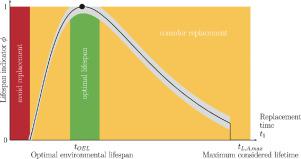Resources, Conservation and Recycling ( IF 13.2 ) Pub Date : 2021-06-23 , DOI: 10.1016/j.resconrec.2021.105704 Torsten Hummen , Harald Desing

|
A longer product use requires less resources, causing less environmental impacts. Even though this assumption may appear intuitive, it is not necessarily the case for all products. Consider a product that causes significant impacts during its service life and loses performance through wear and degradation. Its extended use may cause higher impacts overall than replacing it before it reaches its end-of-life with an evolved alternative. In this paper, we propose a method for finding the replacement time when impacts become minimal, i.e. the optimal environmental lifetime (OEL), taking into account non-linear dynamics of technological efficiency improvements and efficiency degradation during usage. Different replacement options, including lifetime extension strategies such as re-manufacturing, are considered. Based on this, we define an indicator to measure the environmental performance of an achieved lifetime in comparison to the optimum. This lifespan indicator measures the relative achievement of the maximum possible impact savings, when replacing the initial product at OEL. It accounts for unsustainable throughput of materials and waste of resources when deviating from it. To illustrate the application of the method and lifespan indicator, the OEL of residential heating systems are calculated. It reveals that gas boilers shall be replaced in short intervals with evolved gas boilers or – more effectively – with a heat pump. This case study nullifies the common hypothesis that “durability is per se environmentally beneficial”, requiring to evaluate OEL on a case by case basis.
中文翻译:

何时用哪种(循环)策略替换产品?优化方法和寿命指标
产品使用时间越长,需要的资源就越少,对环境的影响也就越小。尽管这个假设看起来很直观,但并不一定适用于所有产品。考虑一种产品,它在其使用寿命期间会产生重大影响,并会因磨损和退化而失去性能。它的长期使用可能会产生比在其生命周期结束之前用进化的替代品替换它更大的整体影响。在本文中,我们提出了一种在影响变得最小时寻找更换时间的方法,即最佳环境寿命(OEL),同时考虑到技术效率改进和使用过程中效率下降的非线性动态。考虑了不同的更换选项,包括寿命延长策略,例如再制造。基于此,我们定义了一个指标来衡量与最佳状态相比达到的寿命的环境性能。这个寿命指标衡量在更换 OEL 的初始产品时最大可能的影响节省的相对成就。当偏离它时,它会导致不可持续的材料吞吐量和资源浪费。为了说明该方法和寿命指标的应用,计算了住宅供暖系统的 OEL。它表明,燃气锅炉应在短时间内更换为改进型燃气锅炉,或者更有效地更换为热泵。该案例研究否定了“耐久性本身对环境有益”的普遍假设,需要逐案评估 OEL。


























 京公网安备 11010802027423号
京公网安备 11010802027423号